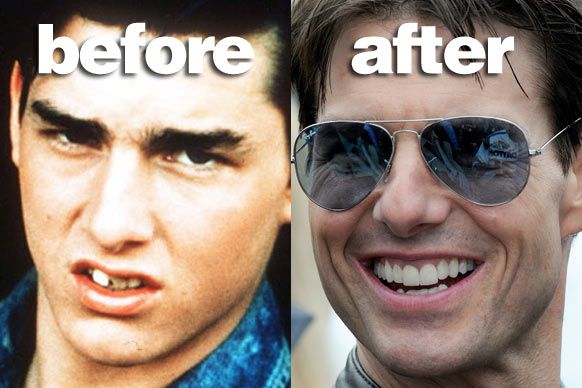In the realm of Hollywood, where the spotlight shines brighter than anywhere else, the allure of a captivating smile often becomes the emblem of a star’s persona. One such example who has captivated audiences not only with his cinematic prowess but also with his dazzling smile is none other than Tom Cruise. For decades, this actor has been the epitome of charm and charisma, and his dental transformation has become a point of fascination, sparking questions and conversations about the influence of a perfect smile.
Before delving into the aesthetic aspects, let’s take a moment to reflect on the early Tom Cruise. His emergence as a Hollywood heartthrob in the 1980s and 90s came accompanied by a not-so-perfect smile. In his formative years, Cruise had noticeable dental imperfections. His teeth were misaligned, with one prominent canine tooth jutting out conspicuously. Such characteristics, however, did not hinder his rise; rather, they added a relatable touch to his screen presence. Audiences perceived him as approachable and authentic—qualities that resonated deeply during the era, amidst a growing fascination with the unattainable standards of beauty.
As Cruise transitioned into one of Hollywood’s most bankable stars, the evolution of his smile became as remarkable as the roles he inhabited. The transformation began subtly, with the actor reportedly undergoing orthodontic treatment to align his teeth. This dental makeover stirred speculation about the motivation behind it. Was it merely a cosmetic enhancement, or did it represent a deeper narrative about self-improvement and the pressures of fame?
The answer lies in the complex interplay of personal and professional aspirations. In an industry that often equates success with aesthetics, a dazzling smile can serve as a significant asset. It can enhance not just appearance but also confidence. For a performer like Cruise, who thrives on charisma and presence, the enhancement of his smile was likely a strategic maneuver. This transformation highlights a unique tension—between the cult of celebrity and an individual’s personal journey towards self-actualization.
The transition from his early, less-polished grin to a commercially attractive one unfolded over a span of years. With improved alignment, whitening treatments, and perhaps even the insertion of veneers, Cruise adopted a smile that radiated perfection. This evolution has been scrutinized endlessly by fans and critics alike, prompting discussions about the impact of dental aesthetics on public perception.
It’s not merely Cruise’s choice to improve his smile that energizes discussions; it’s the symbolism behind it. For many, the allure of his transformation is indicative of a broader cultural phenomenon. The pursuit of the ‘perfect’ smile reflects societal values that prioritize visual appeal, influencing not just the lives of celebrities but also those of everyday individuals. The phenomenon of smile makeover surgery and cosmetic dentistry is on the rise, demonstrating a collective yearning for the kind of confidence that a great smile can impart.
Furthermore, there is a psychological dimension to Cruise’s dental journey that is fascinating. The notion that a perfect smile correlates with success and happiness ties back to age-old beliefs in western culture. From advertisements promising joy and allure to the stringent beauty standards perpetuated in media, the idea of a flawless smile has seeped into our collective consciousness. For Celebrity’s like Cruise, their smiles become iconic, shaping not only their visual identity but also reinforcing the expectations held by fans and the film industry at large.
As modern audiences become increasingly discerning—exposed daily to a medley of edited images and highlight reels—there’s a burgeoning admiration for authenticity and relatability among celebrities. Ironically, in the pursuit of perfection, some stars may veer towards an unrealistic ideal. Cruise’s gradual transformation, however, strikes a balance. He embodies the human experience—the progression from an ordinary smile to an extraordinary one—while still retaining the essence of who he is beneath that polished exterior.
Skepticism and enthusiasm for cosmetic adjustments continue to persist. While some view dental modifications as a breach of authenticity, others celebrate them as forms of self-expression. In Cruise’s case, his smile evolution can be interpreted not merely as vanity but rather as a encapsulation of growth, adaptability, and the embracing of new chapters of life. It challenges the critical lens through which we often assess celebrity decisions, prompting us to consider the multifaceted dimensions of their choices.
In summary, Tom Cruise’s smile, from its unpolished origins to its current captivating form, serves as a microcosm of larger societal trends regarding beauty, authenticity, and self-improvement. His journey takes the audience on more than just a visual ride; it stirs deeper contemplations about who we are and how we decide to present ourselves. Ultimately, the examination of his teeth—before and after—serves as a reflection on our obsession with perfection, the nature of celebrity, and the blend of personal choices that become part and parcel of a public figure’s identity.
As we dissect the apparent simplicity of a smile, it becomes evident that Tom Cruise’s evolution is emblematic of a broader commentary on beauty, the impact of fame on self-perception, and the nuanced ways in which we navigate societal expectations.
